Eastron SDM630MCT-MT Handleiding
Eastron
Meetapparatuur
SDM630MCT-MT
Bekijk gratis de handleiding van Eastron SDM630MCT-MT (2 pagina’s), behorend tot de categorie Meetapparatuur. Deze gids werd als nuttig beoordeeld door 29 mensen en kreeg gemiddeld 4.6 sterren uit 15 reviews. Heb je een vraag over Eastron SDM630MCT-MT of wil je andere gebruikers van dit product iets vragen? Stel een vraag
Pagina 1/2

1.Introduction
This document provides operating, maintenance and
installation instructions. This unit measures and displays
the characteristics of single phase two wires(1p2w),three
phase three wires(3p3w) and three phase four wires(3p4w)
networks.The measuring parameters include voltage(V),
frequency(Hz),current(A),power(kW/Kva/Kvar), mport, i
export and total Energy(kWh/kvArh).The unit can also
measures Maximum demand current and power. his is T
measured over preset periods of up to 60 minutes.
This unit is a 1A or 5A current transformer operated and can
be configured to work with a wide range of CTs. Built-in pulse
and Modbus or M Bus outputs.Configuration is password -
protected.
This unit can be powered from a separate auxiliary (AC or DC)
supply. Alternatively it can be powered from the monitored
supply by linking the voltage reference and neutral reference in
to terminals 5 and 6 (Please refer to wiring diagram).
1.1 Unit Characteristics
The unit can measure and display:
• Voltage and THD% (total harmonic distortion) of all phases
• Line frequency
• Currents,current demand and current THD% of all phases
• Power, maximum power demand and power factor
• Active energy import d and exportede
• Reactive energy imported and exported
1.2 Current Transformer Primary Current
1.3 RS485 Modbus RTU
1.4 Pulse output
Two pulse outputs that pulse measured active and reactive
energy.The Pulse 2 constant for active energy is 3200imp/kWh.
(Terminals 11 & 12) The pulse width for Pulse 1 can be set
from the set-up menu (Terminals 9 & 10).
2.Start Up Screens
The first screen lights up
all display segments and
can be used as a display
check.
S ftw re version information o a
The interface performs a
self-test and indicates the
result if the test passes.
*After a short delay, the screen will display active energy
measurements.
3.Measurements
The buttons operate as follows:
Selects the Voltage and Current display
screens. In Set-up Mode, this is the “Left”
or “Back” button.
Select the Frequency and Power factor
display screens. In Set-up Mode, this is
the “Up” button.
Select the Power display screens. In Set-
up Mode, this is the “Down” button.
Select the Energy display screens. In Set-
up mode, this is the “Enter” or “Right”
button.
3.1 Voltage and Current
Each successive press of the button selects a new parameter:
Phase to neutral voltages.
Current on each phase.
Phase to neutral voltage
THD%.
Current THD% for each
phase.
3.2 Frequency and Power Factor and Demand
Each successive press of the button selects a new range:
Frequency and Power
Factor (total).
Power Factor of each
phase.
Maximum Power Demand.
Maximum Current
Demand.
3.3 Power
Each successive press of the
button selects a new range:
Instantaneous Active
Power in kW.
Instantaneous Reactive
Power in kVAr.
Instantaneous Volt-Amps
in KVA.
Total kW, kVArh, kVA.
3.4 Energy Measurements
Each successive press of the button selects a new range:
Total active energy in kWh.
Total reactive energy in
kVArh.
4.Set Up
To enter set-up mode, press the
button for 3 seconds,
until the password screen appears.
Setting up is password-
protected so you must
enter the correct password
(default ‘1000’) before
processing.
If an incorrect password
is entered, the display will
show:
PASS Err
To exit setting-up mode, press
repeatedly until the
measurement screen is restored.
4.1 Set-up Entry Methods
Some menu items, such as password and CT, require a
four-digit number entry while others, such as supply system,
require selection from a number of menu options.
4.1.1 Menu Option Selection
and buttons to scroll through the
different options of the set up menu.
2. Press
to confirm your selection
3. If an item flashes, then it can be adjusted by the
and
buttons.
4. Having selected an option from the current layer, press
to confirm your selection. The SET indicator will appear.
5. Having completed a parameter setting, press
to return
to a higher menu level. The SET indicator will be removed
and you will be able to use the
and buttons for
further menu selection.
6. On completion of all setting-up, press
repeatedly until
the measurement screen is restored.
4.1.2 Number Entry Procedure
When Setting up the unit, some screens require the entering
of a number. In particular, on entry to the setting up section, a
password must be entered. Digits are set individually, from left
to right. The procedure is as follows:
1. The current digit to be set flashes and is set using the
and
buttons.
2. Press
to confirm each digit setting. The SET indicator
appears after the last digit has been set.
3. After setting the last digit, press
to exit the number
setting routine. The SET indicator will be removed.
4.2 Change Password
Use the and
to choose the change
password option.
Press the to enter the
change password routine.
The new password screen
will appear with the first
digit flashing.
Use and to set
the first digit and press
to confirm your
selection. The next digit
will flash.
Repeat the procedure for
the remaining three digits.
After setting the last digit,
SET will show.
Press
to exit the number setting routine and return to the
Set-up menu. SET will be removed.
4.3 DIT Demand Integration Time
This sets the period in minutes over which the current
and power readings are integrated for maximum demand
measurement. The options are: off, 5, 10,15 30,60 minutes.
From the set-up menu, use
and buttons
to select the DIT option.
The screen will show
the currently selected
integration time.
Press to enter the
selection routine. The
current time interval will
flash.
Use and
buttons to select the time
required.
Press to confirm the
selection. SET indicator
will appear.
Press to exit the DIT selection routine and return to the menu.
4.4 Supply System
Use this section to set the type of electrical system.
From the set-up menu, use
and buttons to
select the system option.
The screen will show the
currently selected power
supply.
Press to enter the
selection routine. The
current selection will flash.
Use and
buttons to select the
required system option:
1P2(W),3P3(W) ,3P4(W).
Press to confirm the
selection. SET indicator
will appear.
Press
to exit the system selection routine and return to
the menu. SET will disappear and you will be returned to the
main set-up Menu.
4.5 CT
The CT option sets the secondary current (CT2 1A or 5A)
of the current transformer (CT) that wires to the meter.
From the set-up menu,
use and buttons
to select the CT option.
Secondary CT setting
Press to enter the
CT secondary current
selection routine.:5A/1A
4.6 PT
The PT option sets the secondary voltage (PT2 100 to 500V) of
the voltage transformer (PT) that may be connected to the meter.
and buttons
to select the PT option.
The screen will show the
voltage PT secondary
voltage value. The default
value is 230V.
Secondary PT setting
Press to enter the
PT secondary voltage
selection routine. The
range is from 100 to 500V.
For example, if set the ratio to be 100,it means the primary
voltage equals secondary voltage x100.
Warnings
Important Safety Information is contained in the
Maintenance section. Familiarize yourself with this
information before attempting installation or other
procedures. Symbols used in this document:
Risk of Danger: These instructions contain
important safety information. Read them before
starting installation or servicing of the equipment.
Caution: Risk of Electric Shock
User Manual V1.1
1. Use the
The unit has a default setting of 3Phase 4wire (3P4).
MD
MD
MD
MD
MD
MD
MD
MD
MD
MD
MD
MD
MD
Three Phase Multifunction Energy Meter
Use
DIN RAIL SMART METER
FOR SINGLE AND THREE PHASE
ELECTRICAL SYSTEMS
* Please note for the MID approved version device,you will
only have one opportunity to set the ratio.
!
SDM630 MCT-MT
C1C2
C1 C2
C1 C2
C1 C2
T1 reactive energy in kVArh
T2 reactive energy in kVArh
T1 active energy in kWh
T2 active energy in kWh
SDM630MCT-MT has a RS485 port with Modbus RTU
protocol.
Rs485 provide a means of remotely monitoring and
controlling the unit. Set-up screens are provided for
settingup the communication port.
C1 C2
• Multi-tariff
SDM630MCT-MT is CT operated you will need to set the
correct CT ratio.
C1 C2
T3 active energy in kWh
C1 C2
T4 active energy in kWh
C1 C2
T3 reactive energy in kVArh
C1 C2
T4 reactive energy in kVArh
Set CT Ratio value
Press to enter the
CT Ratio setting screen.
The range is from 0001
to 2000.
For example, if using a 100/5A current transformer you
will enter 0020, as you need to divide the primary by the
secondary to get the ratio (CT rate).
Set PT ratios value
Press to enter the PT
ratio screen.
The range is from 0001
to 9999.
As an example: If using 100/5A CT, you will need to insure
CT2 (Secondary) is set to 5 and CT rate is 0020. You divide
the primary by the secondary to get the CT rate to be entered
(100/5=20).
• Changing password
• Supply system selection 1p2w, 3p3w, 3p4w
• Demand Interval time
• Reset for demand measurements
• Pulse output duration
The unit has password-protected set-up screens for:

MID
4.7.1 Pulse rate
Use this to set the energy represented by each pulse.
Rate can be set to 1 pulse per
0.01kWh/0.1kWh/1kWh/10kWh/100kWh.
(It shows 1 impulse = 10kWh/kVArh)
From the set-up menu,
use
and
buttons
to select the Pulse Rate
option.
Press to enter the
selection routine. The
current setting will flash.
0.01/0.1/1/10/100kWh/
kVArh per pulse.
Use
and buttons to choose pulse rate.
On completion of the entry procedure, press to confirm
the setting and press
to return to the main set up menu.
4.7.2 Pulse Duration
The energy monitored can be active or reactive and the pulse
width can be selected as 200, 100 or 60ms.
(It shows pulse width of 200ms)
From the set-up menu,
use
and buttons
to select the Pulse width
option.
Press to enter the
selection routine. The
current setting will flash.
Use
and buttons to choose pulse width.
On completion of the entry procedure press to confirm
the setting and press
to return to the main set-up menu.
4.8 Communication
There is a RS485 port can be used for communication using
Modbus RTU protocol. For Modbus RTU, parameters are
selected from Front panel.
4.8.1 RS485 Address
(The range is from 001 to 247)
From the set-up menu,
and
buttons to
select the address ID.
Press button to enter
the selection routine. The
current setting will be
flashing.
Use and
buttons to choose Modbus
address (001 to 247).
On completion of the entry procedure, press
button to
confirm the setting and press
button to return the main
set-up menu.
5.Specifications
5.1 Measured Parameters
The unit can monitor and display the following parameters of a
single phase two wire(1p2w), three phase three wire(3p3w) or
three phase four wire(3p4w) system.
5.1.1 Voltage and Current
• Phase to neutral voltages 100 to 289V a.c. (not for 3p3w
supplies).
• Voltages between phases 173 to 500V a.c. (3p supplies
only).
• Percentage total voltage harmonic distortion (THD%) for
each phase to N ( not for 3p3w supplies).
• Percentage voltage THD% between phases (three phase
supplies only).
• Current THD% for each phase
5.1.2 Power factor and Frequency and
• Frequency in Hz
• Instantaneous power:
• Power 0 to 3600 MW
• Reactive power 0 to 3600 MVAr
• Volt-amps 0 to 3600 MVA
5.3 Accuracy
• Voltage 0.5% of range maximum
• Current 0.5% of nominal
• Frequency 0.2% of mid-frequency
• Power factor 1% of unity (0.01)
• Active power (W) 1% of range maximum±
• Reactive power (VAr) 1% of range maximum±
• Apparent power (VA) 1% of range maximum±
• Active energy (Wh) Class 1 IEC 62053-21
• Reactive energy (VArh) 1% of range maximum±
• Total harmonic distortion 1% up to 31st harmonic
• Response time to step input 1s, typical, to >99% of
final reading, at 50 Hz.
5.4 Auxiliary Supply
Two-way fixed connector with 2·5mm2 stranded wire capacity.
85 to 275V a.c. 50/60Hz ±10% or 120V to 380V d.c. ±20%.
Consumption < 10W.
5.5 Interfaces for External Monitoring
Three interfaces are provided:
• RS485 communication channel that can be programmed
via protocol remotely.
• Pulse output(Pulse 2) 3200imp/kWh (not configurable)
The Modbus configuration (baud rate etc.) and the pulse
relay output assignments (kW/kVArh, import/export etc.) are
configured through the set-up screens.
5.5.1 Pulse Output
The pulse output can be set to generate pulses to represent
kWh or kVArh.
Rate can be set to generate 1 pulse per:
0.01 = 10 Wh/VArh
0.1 = 100 Wh/VArh
1 = 1 kWh/kVArh
10 = 10 kWh/kVArh
100 = 100 kWh/kVArh
Pulse width 200/100/60 ms
Relay Rating 240V ac 50mA
5.5.2 RS485 Output for Modbus RTU
For Modbus RTU, the following RS485 communication
parameters can be configured from the set-up menu:
Baud rate 2400, 4800, 9600, 19200, 38400
Parity none (default) / odd / even
Stop bits 1 or 2
RS485 network address nnn – 3-digit number, 1 to 247
Modbus Word order Hi/Lo byte order is set automatically to
normal or reverse. It cannot be configured from the
set-up menu.
5.6 Reference Conditions of Influence
Influence Quantities are variables that affect measurement
errors to a minor degree. Accuracy is verified under nominal
value (within the specified tolerance) of these conditions.
• Ambient temperature 23°C ±1°C
• Input frequency 50 or 60Hz ±2%
• Input waveform Sinusoidal (distortion
factor < 0·005)
• Auxiliary supply voltage Nominal ±1%
• Auxiliary supply frequency Nominal ±1%
• Auxiliary supply waveform (if AC) Sinusoidal (distortion
factor < 0·05)
• Magnetic field of external origin Terrestrial flux
5.7 Environment
• Operating temperature 25°C to +55°C*-
• Storage temperature 40°C to +70°C*-
• Relative humidity 0 to 95%, non-
condensing
• Altitude Up to 3000m
• Warm-up time 1 minute
• Vibration 10Hz to 50Hz, IEC
60068-2-6, 2g
• Shock 30g in 3 planes
* Maximum operating and storage temperatures are in the
context of typical daily and seasonal variation.
5.8 Mechanics
• DIN rail dimensions 72 x 94.5 mm (WxH)
per DIN 43880
• Mounting DIN rail (DIN 43880)
• Sealing Ip51 (indoor)
• Material Self-extinguishing
Ul94 V-0
6.Dimensions
7.Installation
Max. Demand
Quantities
MD
MD
MD
MD
MD
Press
to confirm the setting and press
to return to
the main set-up menu.
• Maximum demanded power since last Demand reset
Power factor
• Maximum neutral demand current, since the last Demand
reset (for three phase supplies only)
5.1.3 Energy Measurements
• Import/Export active energy 0 to 9999999.9 kWh
• Import/Export reactive energy 0 to 9999999.9 kVArh
• Total active energy 0 to 9999999.9 kWh
• Total reactive energy 0 to 9999999.9 kVArh
5.2 Measured Inputs
Voltage inputs through 4-way fixed connector with 2.5mm²
stranded wire capacity.single phase two wire(1p2w), three
phase three wire(3p3w) or three phase four wire(3p4w)
unbalanced. Line frequency measured from L1 voltage or
L3 voltage.
Three current inputs (six physical terminals) with 2.5mm²
stranded wire capacity for connection of external CTs. Nominal
rated input current 5A or 1A a.c. Rms.
Zhejiang Eastron Electronic Co , Ltd. .
Building 13, No 1369 Chengnan Rd. .
Jiaxing, Zhejiang, CHINA
Email:sales@eastrongroup.com
Web:www.eastron.com.cn
TM
Tel:86 573 83698881/83698882
Tel:86 573 83698883
MD
5. 9 Declaration of Conformity(for the MID
approved version meter only)
1000 = 1000 kWh/kVArh
1 2 3 4
L1
L2
L3
N
1 2 3 4
L1
L2
L3
15 16
17 18
19 20
1 2 3 4
L1
N
P2 P1
S2 S1
P2 P1
S2 S1
P2 P1
S2 S1
P1P2
S1S2
P2 P1
S1S2
P1P2
S1
S2
3 PHASE 4 WIRE3 PHASE 3 WIRE1 PHASE 2 WIRE
15 16
17 18
19 20
15 16
17 18
19 20
MEASURED VOLTAGE CURRENT INPUTS
MEASURED VOLTAGE
MEASURED VOLTAGE
CURRENT INPUTS
CURRENT INPUTS
The wiring diagram of SDM630MCT V2 series has little
difference from different models. please make sure the
wiring is correct before turning on power of the meter.
Current and Voltage inputs
Definitions of other terminals
9 10 11 12 13 14
5 6
AUXILIARY
SUPPLY
L N
7 8
POWER
OUTPUT
L N
1 2 RS485
B AGND
SDM630MCT-MT
4.8.2 Baud Rate
From the set-up menu,
use and buttons
to select the Baud Rate
option.
Press to enter the
selection routine. The
current setting will flash.
Use and
buttons to choose Baud
rate 2.4k. 4.8k, 9.6k, 19.2k,
38.4k
On completion of the entry procedure, press
to confirm
the setting and press
to return to the main set-up menu.
4.8.3 Parity
From the set-up menu, use
and buttons to
select the parity option.
Press to enter the
selection routine. The
current setting will flash.
Use and buttons
to choose parity (EVEN /
ODD / NONE (default)).
On completion of the entry procedure, press
to confirm
the setting and press
to return to the main set-up menu.
4.8.4 Stop bits
From the set-up menu, use
and buttons to
select the stop bit option.
Press to enter the
selection routine. The
current setting will flash.
Use and
buttons to choose stop bit
(2 or 1)
On completion of the entry procedure, press
to confirm
the setting and press
to return to the main set-up menu.
4.9 Backlit set-up
Default:60
Press
to confirm the setting and press
to return to
the main set-up menu.
MD
MD
MD
MD
MD
MD
4.10 CLR
The meter provides a function to reset the maximum demand
value of current and power.
From the set-up menu, use
and buttons to
select the reset option.
MD
The meter provides a function to set the blue backlit
lasting time( 0/5/10/30/60/120 minutes).
If it’s setted as 5,the backlit
will be off in 5minutes.
Use and
buttons to choose the time
MD
Option 0 means the backlit always on here.
Note: Default is 1, and only when the parity is
NONE that the stop bit can be changed to 2.
to select the Pulse output
option.
Press to enter the
selection routine. The unit
symbol will flash.
Use and
buttons to choose kWh or
kVArh.
On completion of the entry procedure, press
to confirm
the setting and press
to return to the main set up menu.
MD
This option allows you to configure the pulse output. The
output can be set to provide a pulse for a defined amount of
energy active or reactive. Use this section to set up the relay
pulse output—Units: kWh, kVArh
From the set-up menu, use
and buttons
MD
4.7 Pulse Output
Press to enter the
selection routine. The dIt
will flash.
We Zhejiang Eastron Electronic Co.,Ltd.
Declare under our sole responsibility as the manufacturer that the
poly phase multifuntion electrical energy meter “SDM630MCT-MT
Serise”
correspond to the production model described in the EU
-type examination certificate and to the requirements of the
Directive 2014/32/EU EU type examination certificate number
0120/SGS0142. Identification number of the NB0120.
4.11 CT reversal
Use the and buttons
to select the menu option.
Hold the button to view
the sub-menu.
MD
This screen will display,
you can change “Forward”
to “Reverse” on each
individual CT connection.
If the CT connections are incorrectly wired, they can be reversed
through the “Set System Continued” menu:
Hold the button to
confirm your adjustment.
You can then move on to
IB or IC using the and
buttons.
MD
4.12 Date and Time set-up
From the set-up menu, use
and buttons to
select the parity option.
From the set-up menu, use
and buttons to
select the time option.
MD
MD
Press to enter the
selectionroutine, the current
setting will flash.Use and
buttions to select the time
potion.
MD
Press to enter the
selection routine, the currect
setting will flash. Press
and to select value,
press to confirm.
MD
Product specificaties
| Merk: | Eastron |
| Categorie: | Meetapparatuur |
| Model: | SDM630MCT-MT |
Heb je hulp nodig?
Als je hulp nodig hebt met Eastron SDM630MCT-MT stel dan hieronder een vraag en andere gebruikers zullen je antwoorden
Handleiding Meetapparatuur Eastron
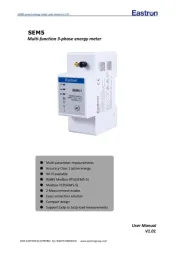
29 Juli 2025
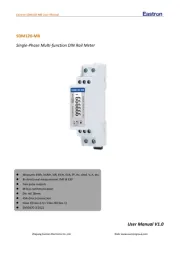
29 Juli 2025

29 Juli 2025
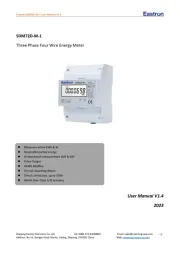
29 Juli 2025
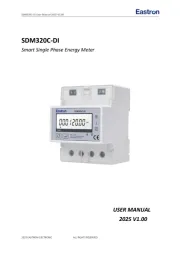
28 Juli 2025
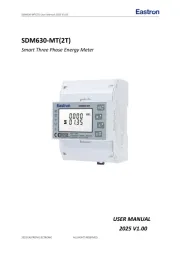
28 Juli 2025
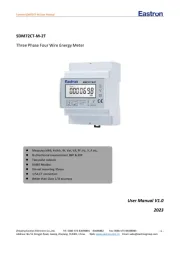
28 Juli 2025
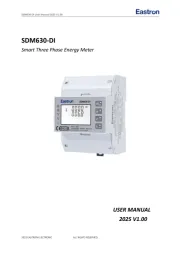
28 Juli 2025
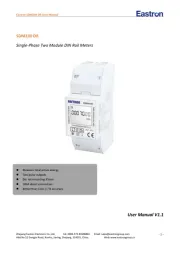
16 Juli 2025

16 Juli 2025
Handleiding Meetapparatuur
- Owon
- DriveTest
- Brandson
- Truelife
- Milesight
- SensoProtect
- Tektronix
- Powerfix
- Victron Energy
- Cablexpert
- National Geographic
- Ideal
- Kreg
- Eizo
- Meec Tools
Nieuwste handleidingen voor Meetapparatuur
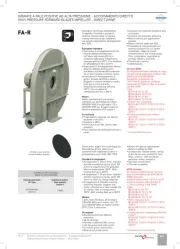
16 September 2025
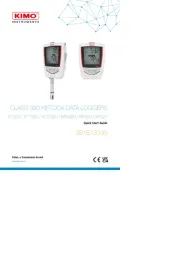
16 September 2025
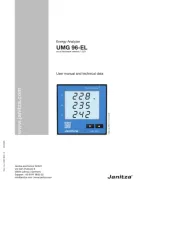
16 September 2025
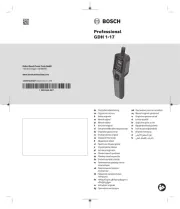
15 September 2025
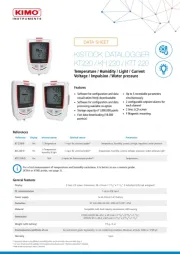
15 September 2025
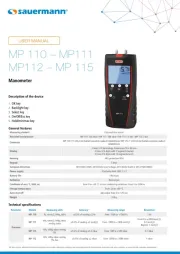
15 September 2025
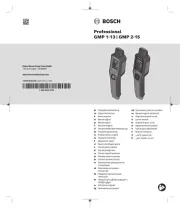
15 September 2025
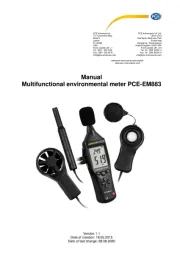
15 September 2025
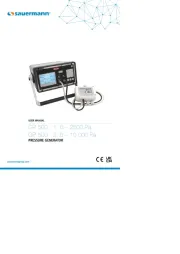
15 September 2025
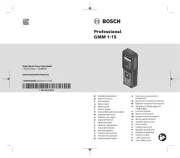
15 September 2025